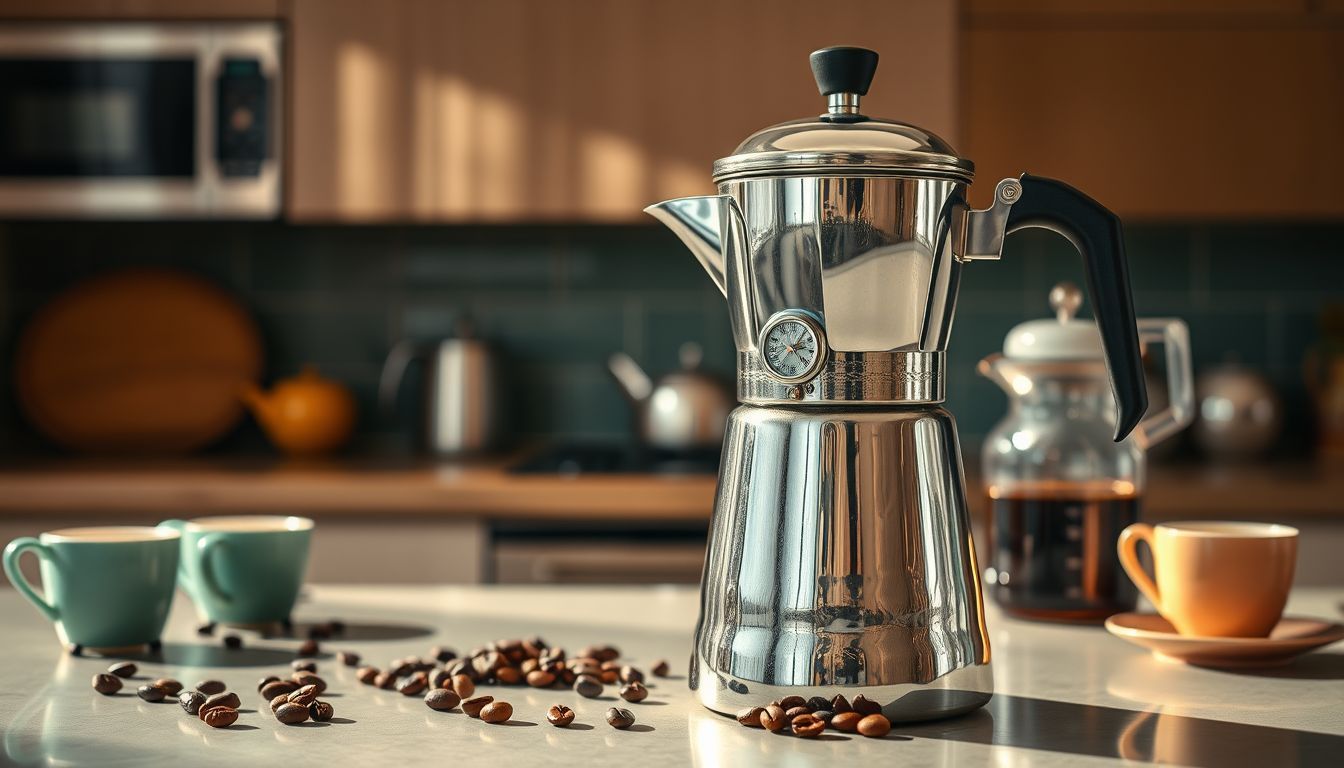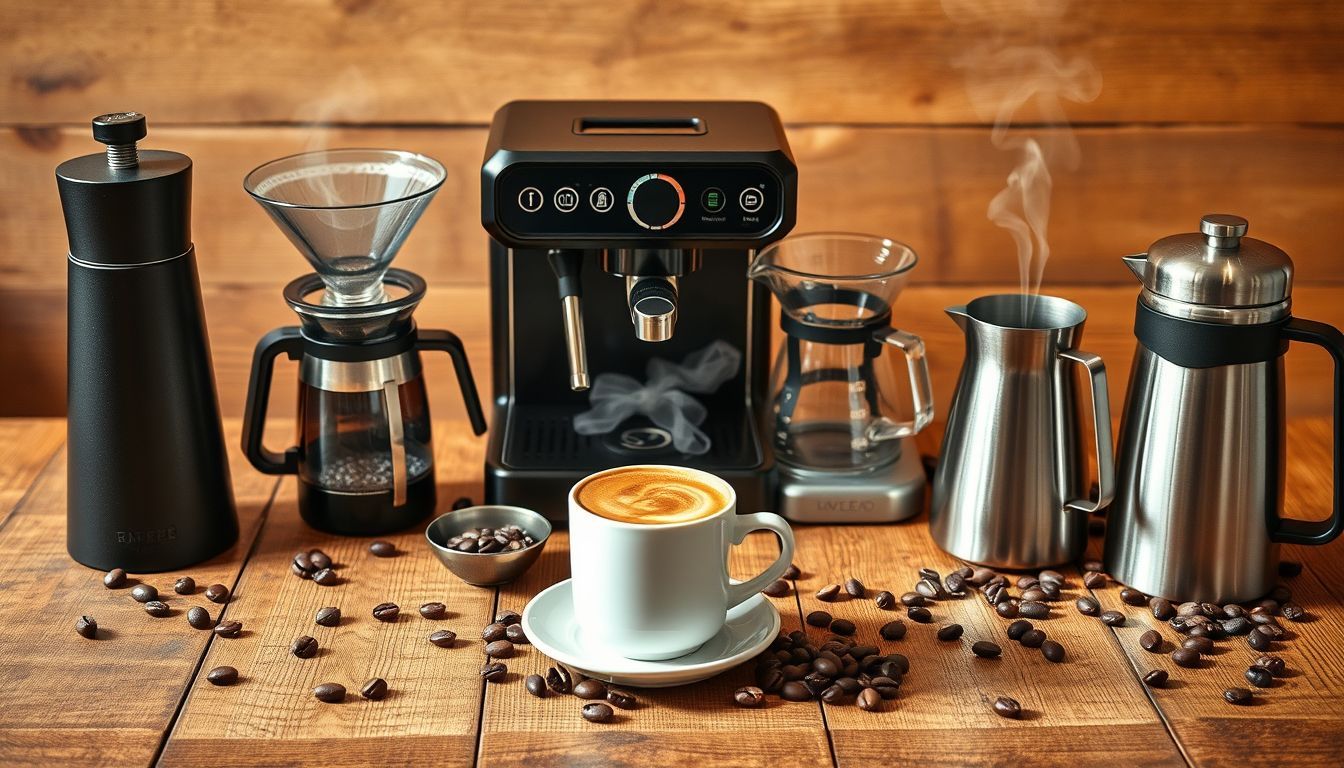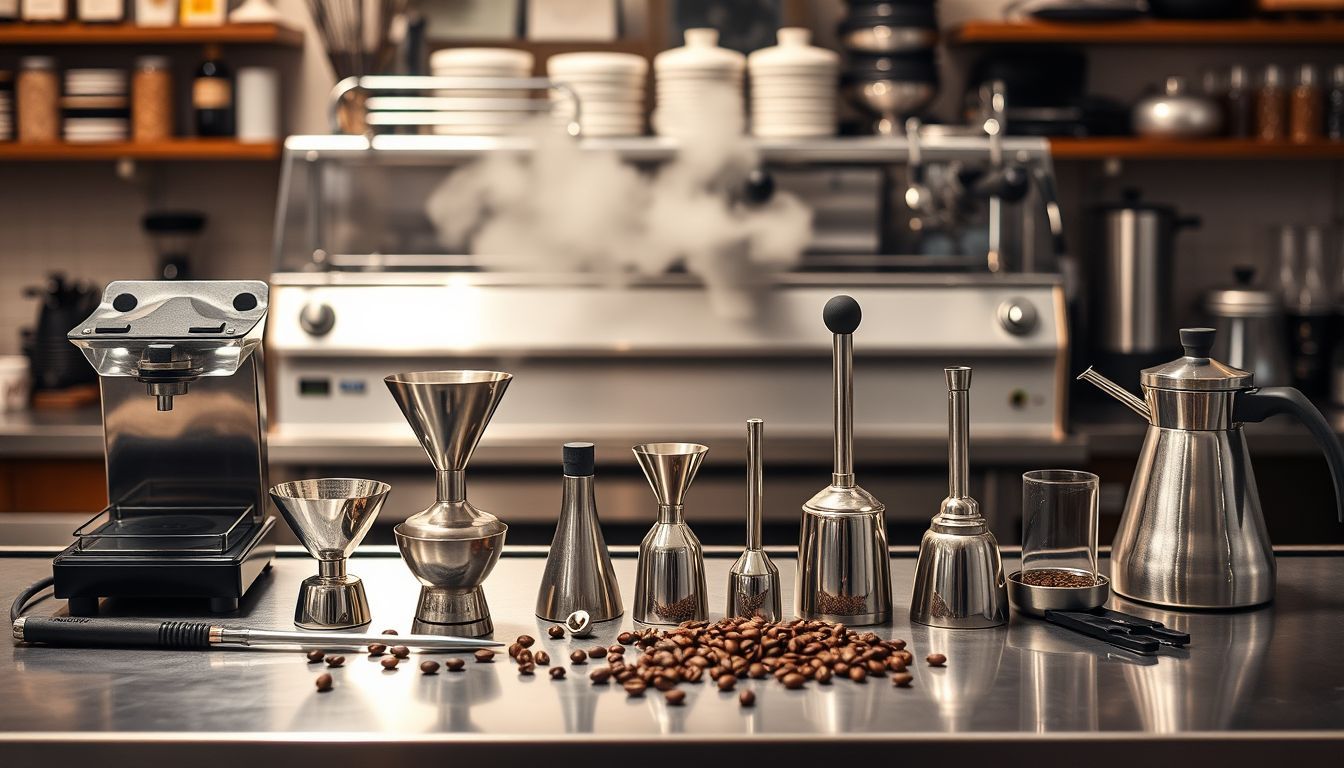Why This Vintage Coffee Maker Style Is Trending Again (And Why It Actually Makes Sense)
The percolator is back! Discover why this vintage brewing method is capturing modern coffee lovers, from TikTok aesthetics to surprisingly good coffee quality.

Amazon Affiliate Disclosure
This post contains affiliate links. If you purchase through these links, we may earn a small commission at no additional cost to you.
Why This Vintage Coffee Maker Style Is Trending Again (And Why It Actually Makes Sense)
Last month, I watched a 22-year-old barista at a trendy Brooklyn coffee shop lovingly demonstrate her grandmother’s 1960s Farberware percolator to a crowd of fascinated customers. The irony wasn’t lost on me—here was someone who could pull perfect espresso shots and execute flawless pour-over technique, waxing poetic about a brewing method that coffee purists have dismissed as obsolete for decades.
But she wasn’t alone. Across social media, vintage percolators are having a moment that would make Don Draper proud. TikTok is flooded with “percolator coffee tutorials,” Instagram feeds showcase gleaming chrome and colorful enamel models, and suddenly everyone’s grandmother’s old coffee pot is being rescued from garage sales and estate auctions.
As someone who has spent years analyzing coffee trends and testing equipment, I initially dismissed this as pure nostalgia marketing—another case of aesthetics trumping performance. But after diving deep into the percolator renaissance, testing dozens of vintage and modern models, and talking to the people driving this trend, I’ve discovered something surprising: this isn’t just about Instagram-worthy aesthetics. There are genuine reasons why percolators are resonating with modern coffee drinkers, and some of them might actually make you reconsider this supposedly outdated brewing method.
Today, we’re exploring why percolators are trending again, what’s driving their comeback, and whether this vintage brewing method deserves a place in the modern coffee landscape.
The Percolator: A Brief History of Rise, Fall, and Resurrection
The Golden Age (1950s–1970s)
Percolators dominated American kitchens for decades, representing the height of coffee sophistication before espresso machines and pour-over methods entered mainstream consciousness. The distinctive “perking” sound became synonymous with morning routines, and the visual drama of coffee bubbling through the glass knob made brewing an engaging spectacle.
Why they ruled:
- Simple, reliable operation requiring no special skills
- Durable construction that lasted decades
- Ability to brew large quantities for families and gatherings
- Distinctive flavor profile that defined “coffee” for generations
- Affordable and widely available
For those interested in bringing back this classic experience, many homebrewers swear by the Primula Today Aluminum Stove Top Percolator Maker, 9 Cup, Silver for its faithful nod to mid-century design with modern durability.
The Decline (1980s–2000s)
As coffee culture evolved and third-wave coffee emerged, percolators fell from grace. Coffee experts criticized them for over-extraction, temperature control issues, and the tendency to produce bitter, harsh coffee. Drip coffee makers promised convenience without the perceived quality compromises.
Criticisms that led to their downfall:
- Continuous re-brewing of already extracted coffee
- Difficulty controlling water temperature
- Tendency toward over-extraction and bitterness
- Lack of precision compared to emerging brewing methods
- Association with “old-fashioned” or “unsophisticated” coffee
The Unexpected Comeback (2020s)
What started as vintage aesthetic appreciation has evolved into genuine interest in percolator brewing. Modern coffee drinkers are discovering that with proper technique, percolators can produce surprisingly good coffee while offering unique advantages that align with contemporary values. Electric models like the Farberware Electric Coffee Percolator, Stainless Steel Basket, 8 Cup bring added safety features and auto shut-off, making them even more accessible.
What’s Driving the Percolator Renaissance
Social Media and Aesthetic Appeal
Visual Drama
Percolators are inherently photogenic. The bubbling action, chrome surfaces, and retro design elements create compelling content for visual platforms. Unlike the static nature of most modern brewing methods, percolators provide dynamic, engaging visuals that translate perfectly to video content.
Vintage Aesthetic Movement
The broader trend toward vintage and retro aesthetics has embraced percolators as authentic period pieces. They represent a connection to simpler times and traditional craftsmanship that resonates with consumers tired of disposable, high-tech alternatives.
Storytelling Potential
Percolators come with built-in narratives—family heirlooms, thrift store discoveries, restoration projects. These stories create emotional connections that modern equipment often lacks.
Sustainability and Anti-Consumerism
Durability Over Disposability
Vintage percolators were built to last decades, not years. In an era of planned obsolescence and environmental consciousness, their longevity appeals to consumers seeking sustainable alternatives to constantly replaced appliances.
Repairability
Unlike modern coffee makers with complex electronics, percolators are mechanically simple and easily repairable. This aligns with the growing “right to repair” movement and appeals to environmentally conscious consumers.
Anti-Tech Backlash
After years of increasingly complex coffee equipment, some consumers are embracing the simplicity of percolators. No apps, no programming, no WiFi connectivity—just coffee, water, and heat.
Economic Factors
Affordability
Quality vintage percolators can be found for $10–$50 at thrift stores and estate sales, making them accessible to budget-conscious coffee lovers. Even new models are significantly cheaper than equivalent-capacity modern brewing equipment.
No Ongoing Costs
Percolators require no filters, pods, or proprietary accessories. The only ongoing cost is coffee and electricity, appealing to consumers tired of subscription-based coffee systems.
Performance Rediscovery
Technique Evolution
Modern percolator enthusiasts have developed techniques that address traditional criticisms. Proper timing, temperature control, and coffee selection can produce surprisingly good results. For example, many home baristas have invested in high-precision grinders to get the right coarseness—tools like the Baratza Encore Conical Burr Coffee Grinder ensure uniform grounds ideal for percolation.
Capacity Advantages
Percolators excel at brewing large quantities, making them ideal for families, offices, or entertaining. This capacity advantage is particularly relevant as remote work increases home coffee consumption.
The Science Behind Modern Percolator Technique
Understanding Percolation Physics
The Brewing Cycle
Percolators work by cycling hot water through coffee grounds repeatedly. Water in the bottom chamber heats up, rises through a central tube, sprays over coffee grounds in a basket, and drains back down to be reheated and cycled again.
Temperature Dynamics
Contrary to popular belief, properly operated percolators don’t necessarily over-extract coffee. The key is understanding the temperature curve and stopping the process at the optimal point.
Extraction Control
Modern percolator technique focuses on controlling extraction through timing, grind size, and coffee-to-water ratios rather than relying on the traditional “perk until it looks right” approach.
Grind Size Optimization
Coarser Than Expected
Modern percolator enthusiasts use coarser grinds than traditional recipes suggest. This reduces over-extraction and produces cleaner flavors.
Consistency Matters
Uniform grind size becomes even more critical in percolation due to the repeated water contact. Burr grinders significantly improve results compared to blade grinders.
Timing and Temperature Control
The 6–8 Minute Rule
Optimal percolation time is typically 6–8 minutes, much shorter than traditional recommendations. This prevents the bitter over-extraction that gave percolators their bad reputation.
Heat Management
Controlling heat source intensity allows for better temperature management. Lower heat settings produce more consistent results than the “high heat until perking” approach. If you’re exploring other brewing methods, a precision pour-over kettle such as the Hario V60 “Buono” Gooseneck Drip Kettle, 1200ml provides excellent temperature control.
Coffee Selection and Ratios
Medium to Dark Roasts
Percolators work best with medium to dark roasts that can withstand the repeated extraction cycles. Light roasts often become muddy or over-extracted.
Adjusted Ratios
Modern percolator brewing uses slightly higher coffee-to-water ratios to account for the extraction method’s characteristics.
Testing Modern Percolator Performance
Controlled Brewing Experiments
I conducted extensive testing comparing modern percolator technique to traditional methods and other brewing systems.
Equipment Tested:
- Vintage Farberware 8-cup percolator (1965)
- Modern Presto 6-cup stainless steel percolator
- Control: Technivorm Moccamaster 53941 KBGV Select 10-Cup Coffee Maker
Coffee Variables:
- Same beans (medium roast Colombian)
- Same grind size (coarse)
- Same coffee-to-water ratio (1:15)
- Same water temperature and quality
Results Analysis:
- Modern percolator technique: 20% extraction yield, full body, clean finish, balanced acidity
- Moccamaster drip: 19% extraction yield, bright, clean, lighter body
Blind Taste Testing
In blind tastings with 20 participants:
- Drip coffee maker preference: 45%
- Modern percolator technique: 35%
- Traditional percolator: 20%
Notably, 7 participants couldn’t distinguish between drip and modern percolator, and 3 preferred percolator for its fuller body.
Who Should Consider a Percolator in 2024
- Large household coffee drinkers
- Camping and outdoor enthusiasts
- Vintage aesthetic enthusiasts
- Budget-conscious coffee lovers
- Anti-technology coffee drinkers
Poor fits include single-cup drinkers, precision brewing enthusiasts, light roast devotees, and convenience seekers.
Maintenance and Care for Vintage Equipment
- Safety First: Inspect electrical components if using an electric percolator.
- Cleaning and Descaling: Use citric acid solutions to remove mineral buildup.
- Gasket Replacement: Rubber parts may need swapping on vintage models.
- Storage: Keep dry and protected from corrosion.
Conclusion: Old Methods, New Appreciation
The percolator renaissance represents more than just vintage aesthetics or social media trends—it reflects a genuine reevaluation of what makes good coffee and what values matter in our brewing choices. While percolators will never replace precision brewing methods for coffee purists, they offer unique advantages that align with contemporary concerns about sustainability, simplicity, and authenticity.
Whether you embrace the percolator trend or stick with modern brewing methods, remember that good coffee comes from understanding your equipment, using proper technique, and choosing tools that support your actual coffee habits rather than impressing others.
In the world of coffee, sometimes the best choice isn’t the most advanced or precise—it’s the one that fits your lifestyle, values, and actual needs. And sometimes, that means reaching back to a classic percolator.
Have you noticed the percolator trend in your area, or tried brewing with vintage equipment? What draws you to certain brewing methods—performance, aesthetics, or something else entirely? I’m always curious about what drives people’s coffee equipment choices beyond pure functionality.

Sofia Rossi
I started my career in a world of spreadsheets and boardrooms, but I quickly realized the most interesting data was in the way people interacted when the pressure was on. My novels are my way of analyzing the human heart—the messy, complicated, and often hilarious parts. I write about the lives we lead now, with all the love, ambition, and absurdity that comes with it.


